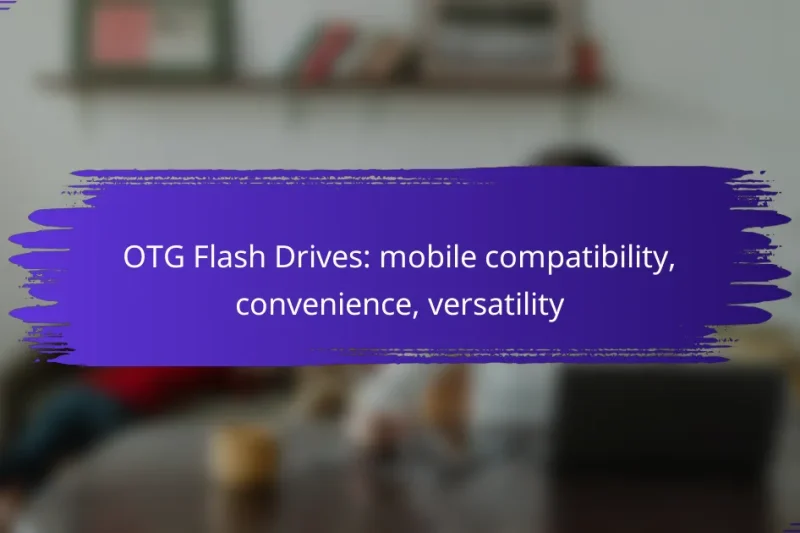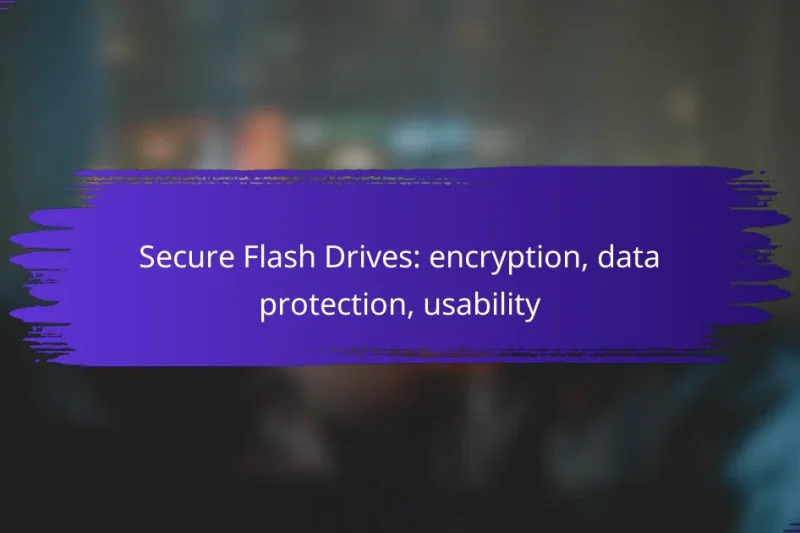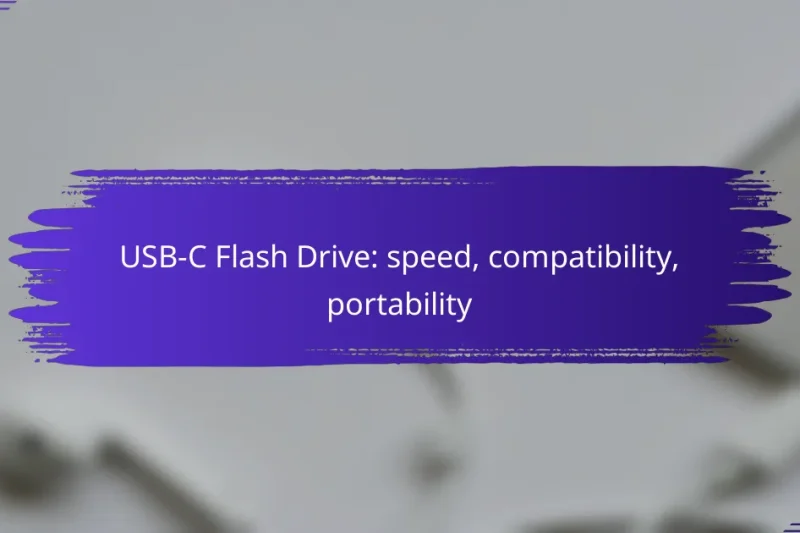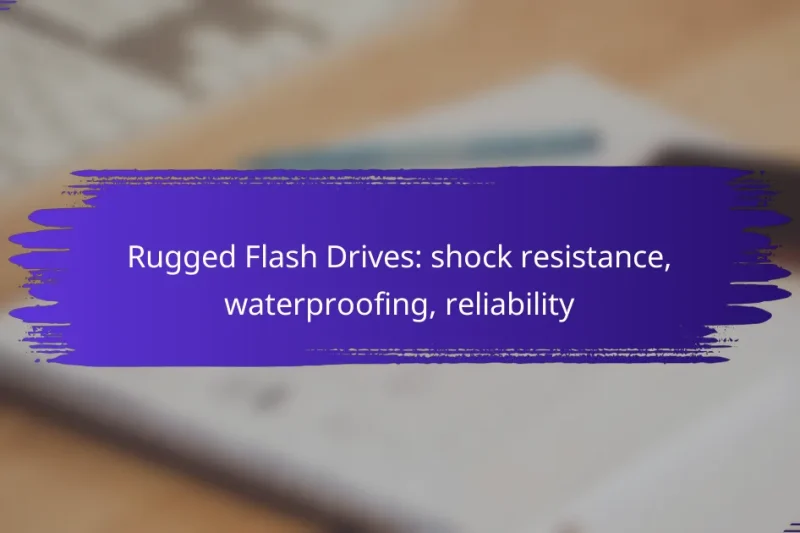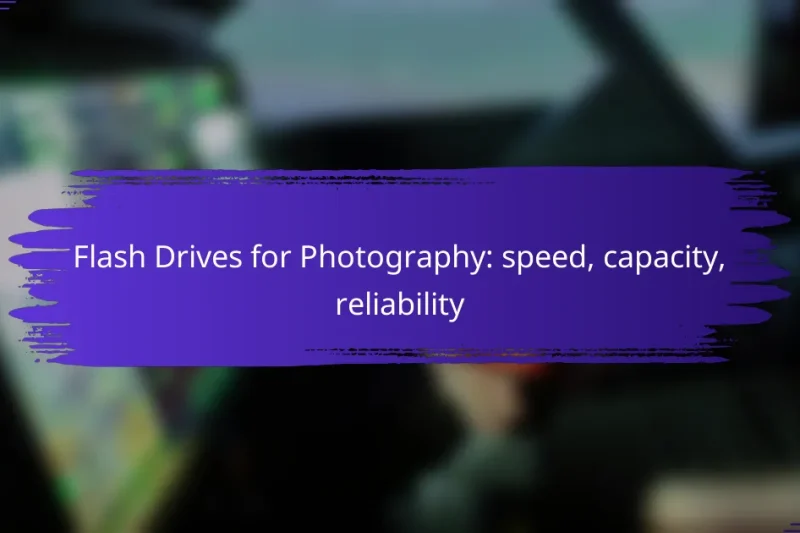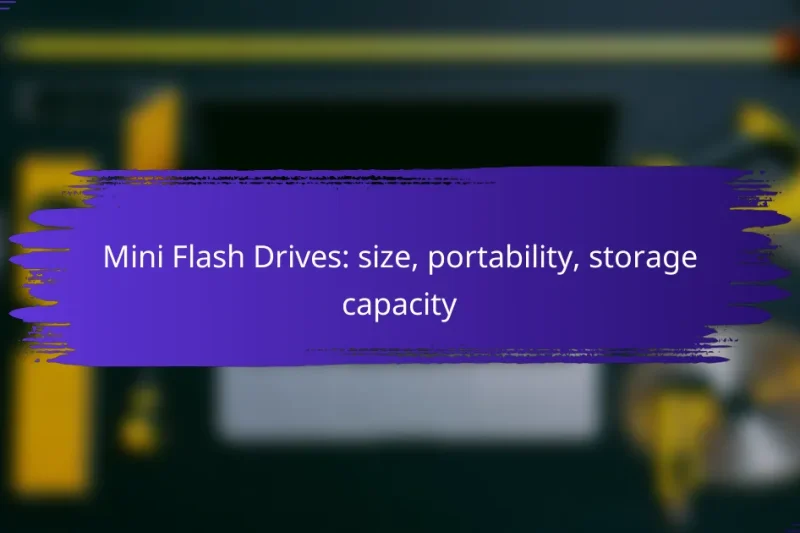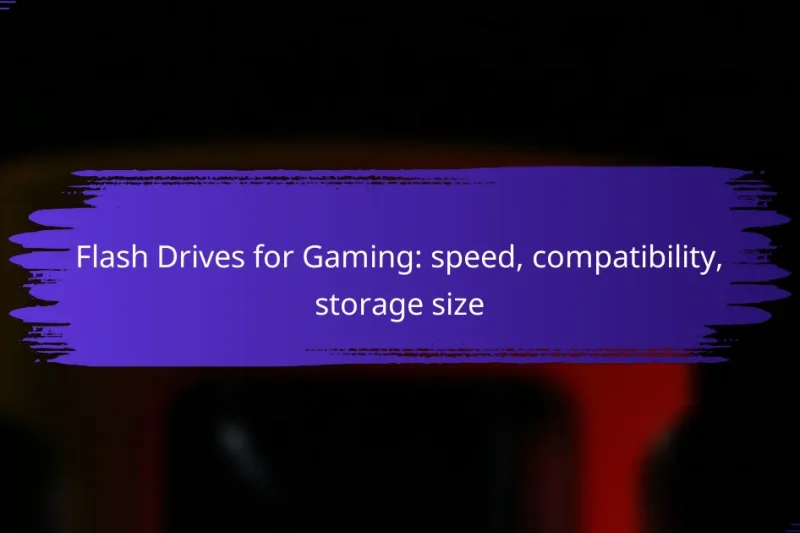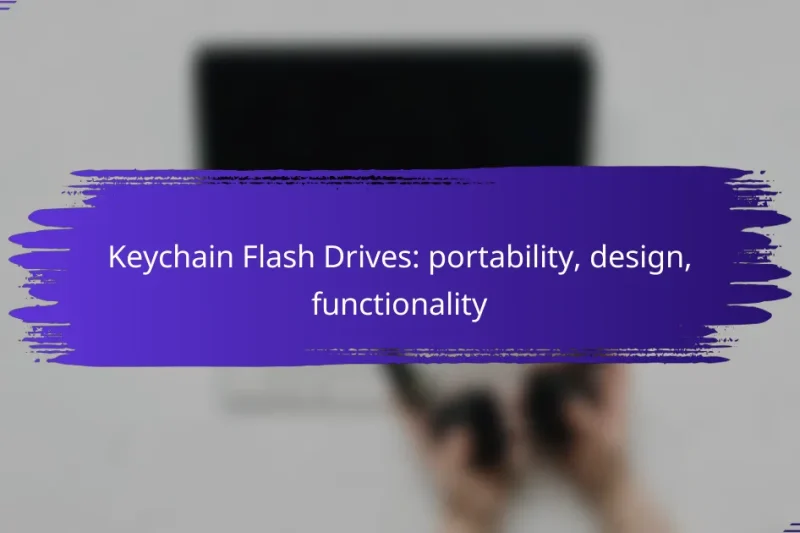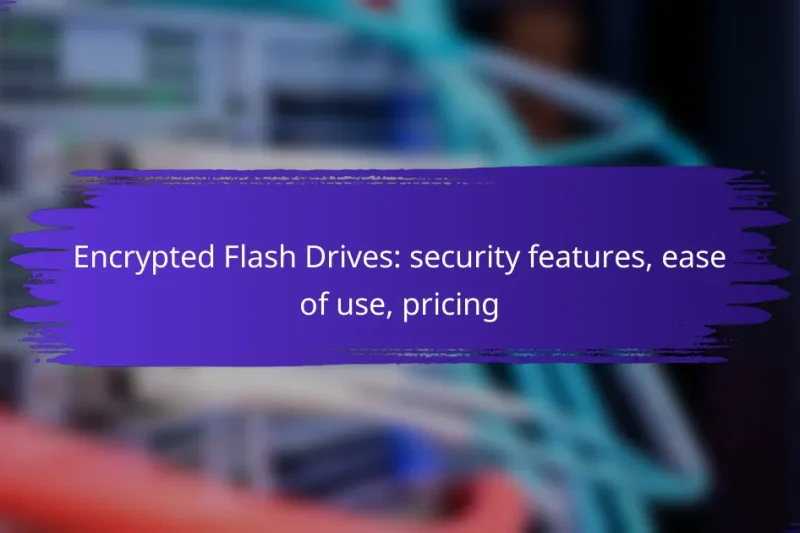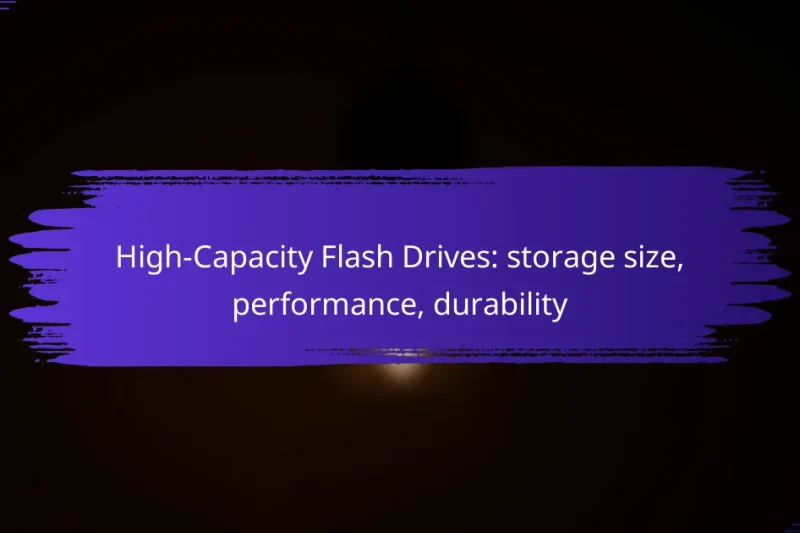OTG flash drives enhance mobile compatibility by allowing direct data transfer between the drive and smartphones … OTG Flash Drives: mobile compatibility, convenience, versatilityRead more
Choosing the Right Flash Drive for Your Needs
Selecting the right flash drive is crucial for optimizing your data storage and transfer needs. Consider factors such as speed, capacity, and durability to ensure you choose a model that meets your specific requirements. With options available from trusted brands featuring advanced technology, you can find a drive that balances performance and reliability for everyday use.
Secure Flash Drives: encryption, data protection, usability
Secure flash drives are essential tools for protecting sensitive data, combining advanced encryption with user-friendly designs. … Secure Flash Drives: encryption, data protection, usabilityRead more
USB-C Flash Drive: speed, compatibility, portability
USB-C flash drives offer a perfect blend of speed, compatibility, and portability, making them essential for … USB-C Flash Drive: speed, compatibility, portabilityRead more
Rugged Flash Drives: shock resistance, waterproofing, reliability
Rugged flash drives are engineered for extreme conditions, offering essential features like shock resistance and waterproofing … Rugged Flash Drives: shock resistance, waterproofing, reliabilityRead more
Flash Drives for Photography: speed, capacity, reliability
When it comes to photography, the ideal flash drives seamlessly blend speed, capacity, and reliability for … Flash Drives for Photography: speed, capacity, reliabilityRead more
Mini Flash Drives: size, portability, storage capacity
Mini flash drives offer an excellent combination of compact size and substantial storage capacity, making them … Mini Flash Drives: size, portability, storage capacityRead more
Flash Drives for Gaming: speed, compatibility, storage size
When it comes to gaming, choosing the right flash drive is essential for optimal performance. The … Flash Drives for Gaming: speed, compatibility, storage sizeRead more
Keychain Flash Drives: portability, design, functionality
Keychain flash drives are the perfect solution for those seeking portability without sacrificing functionality. Their compact … Keychain Flash Drives: portability, design, functionalityRead more
Encrypted Flash Drives: security features, ease of use, pricing
Encrypted flash drives provide a vital solution for safeguarding sensitive information, combining advanced security features with … Encrypted Flash Drives: security features, ease of use, pricingRead more
High-Capacity Flash Drives: storage size, performance, durability
High-capacity flash drives provide an ideal solution for users needing substantial storage, typically ranging from 1TB … High-Capacity Flash Drives: storage size, performance, durabilityRead more
What are the best flash drives for everyday use?
The best flash drives for everyday use combine speed, storage capacity, and durability. Popular options include models from trusted brands that offer USB 3.0 or 3.1 technology for faster data transfer rates, making them suitable for various tasks like file storage, backups, and media transfer.
SanDisk Ultra Flair USB 3.0
The SanDisk Ultra Flair USB 3.0 is a reliable choice for everyday users looking for a balance of performance and affordability. With read speeds up to 150 MB/s, it allows for quick file transfers, making it ideal for moving large files like videos or high-resolution images.
This flash drive is available in various storage capacities, ranging from 16 GB to 256 GB, catering to different needs. Its sleek metal design adds durability, while the retractable connector helps protect the USB plug when not in use.
Samsung BAR Plus USB 3.1
The Samsung BAR Plus USB 3.1 stands out for its robust build and impressive performance. With read speeds reaching 300 MB/s, it significantly reduces transfer times compared to older USB standards, making it perfect for users who frequently move large amounts of data.
This drive is water, shock, and magnet-proof, ensuring your data remains safe under various conditions. It is available in capacities from 32 GB to 256 GB, providing ample space for everyday files, photos, and videos.
Kingston DataTraveler 100 G3
The Kingston DataTraveler 100 G3 is an excellent option for those seeking a budget-friendly flash drive without compromising on quality. It supports USB 3.0 speeds, offering a good balance between performance and cost, with read speeds up to 100 MB/s.
This model is available in capacities from 8 GB to 128 GB, making it suitable for basic storage needs. Its compact design makes it easy to carry, and it is compatible with a wide range of devices, including PCs, laptops, and gaming consoles.
How to choose the right flash drive capacity?
Choosing the right flash drive capacity depends on your storage needs and usage patterns. Consider how much data you typically store, such as documents, photos, or videos, and select a capacity that accommodates your requirements without overspending.
16GB for basic storage
A 16GB flash drive is suitable for basic storage needs, such as transferring documents, small files, or a limited number of photos. This capacity is often adequate for students or professionals who need to carry essential files without large multimedia content.
However, keep in mind that 16GB may fill up quickly if you plan to store high-resolution images or videos. It’s best for users who prioritize portability and only need to store a few gigabytes of data at a time.
64GB for moderate use
The 64GB flash drive strikes a balance between capacity and cost, making it ideal for moderate users. This size can hold a larger collection of photos, music, and documents, making it suitable for casual photographers or those who frequently share files.
With 64GB, you can store several thousand photos or hours of music, providing ample space for everyday use. It’s a good choice for users who need more flexibility without jumping to a higher price point.
256GB for extensive data
If you regularly handle large files, a 256GB flash drive is the best option for extensive data storage. This capacity is ideal for professionals in fields like graphic design, video editing, or software development, where large files are common.
With 256GB, you can store high-definition videos, extensive photo libraries, and large software applications. This size is particularly useful for users who need to back up significant amounts of data or transfer large projects frequently, ensuring you have enough space for all your needs.
What are the key features to consider in a flash drive?
When choosing a flash drive, consider features like read and write speeds, durability, and data encryption options. These aspects significantly affect performance, longevity, and security, making them essential for selecting the right drive for your needs.
Read and write speeds
Read and write speeds determine how quickly data can be transferred to and from the flash drive. Look for drives that offer speeds of at least 100 MB/s for both read and write operations to ensure efficient performance, especially for large files.
USB 3.0 and USB 3.1 drives typically provide faster speeds compared to USB 2.0. If you frequently work with high-resolution videos or large software applications, opting for a drive with higher speeds can save you significant time.
Durability and build quality
Durability and build quality are crucial for ensuring your flash drive withstands daily use. Look for drives made from robust materials, such as metal or reinforced plastic, which can resist physical damage and wear over time.
Some flash drives are also designed to be water-resistant or shockproof, providing additional protection against environmental factors. If you plan to carry your drive frequently, investing in a durable model can prevent data loss and extend its lifespan.
Data encryption options
Data encryption options are vital for protecting sensitive information stored on your flash drive. Many drives offer built-in encryption features that secure your data with passwords or encryption algorithms, making it inaccessible to unauthorized users.
When selecting a drive, check for compliance with encryption standards like AES-256. This ensures your data is well-protected, especially if you store confidential files. Avoid drives without encryption if you handle sensitive information regularly.
How does USB version impact performance?
The USB version significantly affects the performance of flash drives, particularly in terms of data transfer speeds. Newer versions like USB 3.0 and USB 3.1 offer much faster speeds compared to older versions like USB 2.0, which can greatly enhance your experience when transferring large files.
USB 2.0 vs USB 3.0 speed differences
USB 2.0 typically offers a maximum transfer speed of around 480 Mbps, while USB 3.0 can reach speeds up to 5 Gbps, making it over ten times faster. This difference means that transferring large files, such as videos or backups, can take significantly less time with USB 3.0.
For example, a 1 GB file could take about 2-3 minutes to transfer using USB 2.0, whereas the same file might transfer in just a few seconds with USB 3.0. When choosing a flash drive, consider the USB version to ensure it meets your speed requirements.
Benefits of USB 3.1
USB 3.1 further improves upon USB 3.0, offering speeds of up to 10 Gbps. This enhancement is particularly beneficial for users who frequently transfer large files or require quick backups. Additionally, USB 3.1 supports more power, allowing for faster charging of devices connected to the drive.
Another advantage of USB 3.1 is its backward compatibility with previous USB versions, ensuring that you can use it with older devices without sacrificing performance. When investing in a flash drive, opting for USB 3.1 can future-proof your storage needs and enhance overall efficiency.
What are the best flash drives for photographers?
The best flash drives for photographers provide high-speed data transfer, ample storage capacity, and durability. Look for options that support USB 3.0 or higher to ensure quick uploads and downloads of large image files.
Lexar Professional USB 3.0
The Lexar Professional USB 3.0 flash drive is designed for photographers who need reliable performance. With read speeds up to 150 MB/s, it allows for fast transfer of high-resolution images and videos.
This drive is available in various capacities, ranging from 16 GB to 256 GB, making it suitable for different storage needs. Its durable design ensures that it can withstand the rigors of travel and outdoor shoots.
SanDisk Extreme Pro USB 3.1
The SanDisk Extreme Pro USB 3.1 flash drive offers even faster performance, with read speeds reaching up to 420 MB/s. This speed is particularly beneficial for photographers who frequently work with large RAW files.
Available in sizes from 32 GB to 1 TB, this drive provides ample space for extensive photography projects. Additionally, its rugged design includes water and shock resistance, making it a great choice for outdoor photography.
How to secure data on a flash drive?
Securing data on a flash drive involves using methods like encryption and password protection to prevent unauthorized access. These techniques ensure that even if the drive is lost or stolen, the data remains safe from prying eyes.
Using encryption software
Encryption software transforms your data into a coded format that can only be accessed with a specific key or password. Popular options include VeraCrypt, BitLocker (for Windows), and FileVault (for macOS). Each of these tools provides robust security, but they may vary in ease of use and compatibility.
When choosing encryption software, consider factors such as the level of security you need, the types of files you will encrypt, and the operating systems you use. For example, BitLocker is integrated into Windows but may require a specific version of the OS.
To effectively use encryption software, follow these steps: install the software, select the files or folders you want to encrypt, and set a strong password. Remember to keep a backup of your password in a secure location, as losing it could mean losing access to your data permanently.
